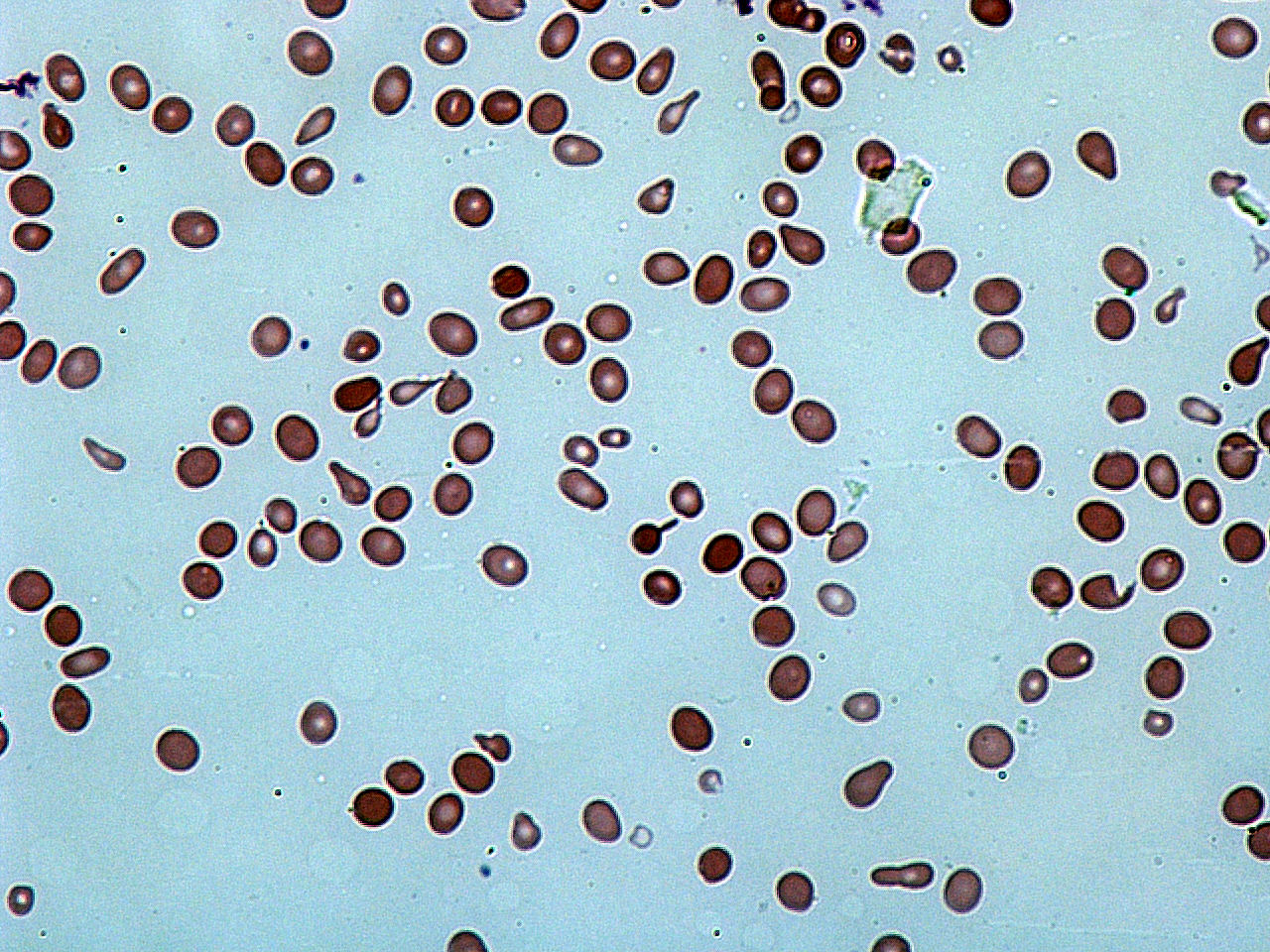Poikilocyte on:
[Wikipedia]
[Google]
[Amazon]
Poikilocytosis is variation in the shapes of

ποικιλόθερμος, Retrieved on 2007-01-12
red blood cells
Red blood cells (RBCs), referred to as erythrocytes (, with -''cyte'' translated as 'cell' in modern usage) in academia and medical publishing, also known as red cells, erythroid cells, and rarely haematids, are the most common type of blood cel ...
. Poikilocytes may be oval, teardrop-shaped, sickle-shaped or irregularly contracted.
Normal red blood cells are round, flattened disks that are thinner in the middle than at the edges. A ''poikilocyte'' is an abnormally-shaped red blood cell. Generally, poikilocytosis can refer to an increase in abnormal red blood cells of any shape, where they make up 10% or more of the total population of red blood cells.
Types

Membrane abnormalities
#Acanthocyte
Acanthocyte (from the Greek word ἄκανθα ''acantha'', meaning 'thorn'), in biology and medicine, refers to an abnormal form of red blood cell that has a spiked cell membrane, due to thorny projections. A similar term is spur cells. Often ...
s or Spur/Spike cells
# Codocyte
Codocytes, also known as target cells, are red blood cells that have the appearance of a shooting target with a bullseye. In optical microscopy these cells appear to have a dark center (a central, hemoglobinized area) surrounded by a white ring ( ...
s or Target cells
# Echinocytes
Echinocyte (from the Greek word ''echinos'', meaning 'hedgehog' or 'sea urchin'), in human biology and medicine, refers to a form of red blood cell that has an abnormal cell membrane characterized by many small, evenly spaced thorny projections.M ...
and Burr cells
# Elliptocyte
Elliptocytes, also known as ovalocytes or cigar cells, are abnormally shaped red blood cells that appear oval or elongated, from slightly egg-shaped to rod or pencil forms. They have normal central pallor with the hemoglobin appearing concentra ...
s and Ovalocytes
# Spherocyte
Spherocytosis is the presence of spherocytes in the blood, i.e. erythrocytes (red blood cells) that are sphere-shaped rather than bi-concave disk shaped as normal. Spherocytes are found in all hemolytic anemias to some degree. Hereditary spheroc ...
s
# Stomatocyte
Hereditary stomatocytosis describes a number of inherited, mostly autosomal dominant human conditions which affect the red blood cell and create the appearance of a slit-like area of central pallor (stomatocyte) among erythrocytes on peripheral bl ...
s or Mouth cells
# Drepanocytes or Sickle Cells
# Degmacyte
A degmacyte or bite cell is an abnormally shaped mature red blood cell with one or more semicircular portions removed from the cell margin, known as "bites". These "bites" result from the mechanical removal of denatured hemoglobin during splenic ...
s or "bite cells"
Trauma
# Dacrocytes or Teardrop Cells # Keratocytes # Microspherocytes and Pyropoikilocytes #Schistocyte
A schistocyte (from Greek for "divided" and for "hollow" or "cell") is a fragmented part of a red blood cell. Schistocytes are sometimes referred to as helmet cells because of their irregular shape from mechanical force.
Several microangiopa ...
s
# Semilunar bodiesDiagnosis
Poikilocytosis may be diagnosed with a test called ablood smear
A blood smear, peripheral blood smear or blood film is a thin layer of blood smeared on a glass microscope slide and then stained in such a way as to allow the various blood cells to be examined microscopically. Blood smears are examined in the i ...
. During a blood smear, a medical technologist/clinical lab scientist spreads a thin layer of blood on a microscope slide and stains the blood to help differentiate the cells. The technologist/clinical lab scientist then views the blood under a microscope, where the sizes and shapes of the red blood cells can be seen.
Treatment
In all cases, the treatment of poikilocytosis depends on its cause. For example, poikilocytosis can be caused by a vitamin deficiency (e.g. vitamin B12,folic acid
Folate, also known as vitamin B9 and folacin, is one of the B vitamins. Manufactured folic acid, which is converted into folate by the body, is used as a dietary supplement and in food fortification as it is more stable during processing and ...
), in which case the treatment is to replenish the deficient vitamin. It can be caused by a digestive disease, such as celiac disease
Coeliac disease (British English) or celiac disease (American English) is a long-term autoimmune disorder, primarily affecting the small intestine. Patients develop intolerance to gluten, which is present in foods such as wheat, rye, spel ...
, in which case the solution may lie in treating the underlying celiac disease so that nutrients can be properly absorbed.
Etymology
The term derives from ''poikilos'' (''ποικίλος''), which means "varied" in Greek.Triantafyllidis Online Lexiconποικιλόθερμος, Retrieved on 2007-01-12
See also
*Anisocytosis
Anisocytosis is a medical term meaning that a patient's red blood cells are of unequal size. This is commonly found in anemia and other blood conditions. False diagnostic flagging may be triggered on a complete blood count by an elevated WBC count ...
References
External links
{{Abnormal clinical and laboratory findings Red blood cell disorders Abnormal clinical and laboratory findings for RBCs